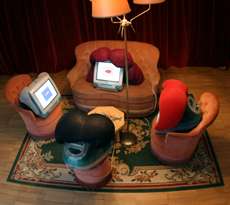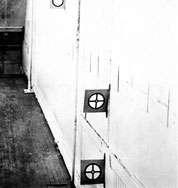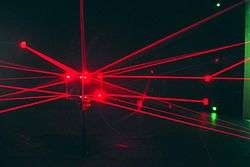G. H. Hovagimyan
G. H. Hovagimyan is an experimental cross media, new media and performance artist who lives and works in New York City.

Life
Hovagimyan was born 1950 in Plymouth, Massachusetts. In 1972, he received a B.F.A. from the University of the Arts in Philadelphia, Pennsylvania and received an M.A. from New York University in 2005. He was a professor at the School of Visual Arts in the MFA Computer Arts Department. He was one of the first artists in New York to start working in Internet Art in 1993 with such artists' online groups as the thing, ArtNetWeb, and Rhizome.[1]
New York City== Artistic practice == Hovagimyan has been working in a variety of forms since the 70s. An internet and new media pioneer, his works range from hypertext pieces to digital performance art, interactive installations and HD video. His works have been exhibited at MoMA, Mass MoCA, The Whitney Museum, The New Museum, The Walker Art Center, Jeu De Paume, MAC Marseille, MAC Lyon, Pompidou Center, Lincoln Center, ICA The Clocktower, The Kitchen, The Alternative Museum, Eyebeam Art & Technology, List Visual Arts Center, La Gaite Du Lyrique, Stuttgart Kunstverein, Steim Institute, the Moscow Center for Contemporary Art, Postmasters Gallery, Pace Digital Gallery.
His works are in the collections of The Walker Art Center, The Whitney Museum, The Alternative Museum, Computer Fine Arts Collection and Perpetual Art Machine.
Hovagimyan's work often provides a somewhat humorous, yet seriously rebellious and innovative approach to social media, its constructs, and the division between the physical and digital self. The use of technology as the primary medium for his work questions all of these elements simultaneously. Viewers sometimes use their physical bodies to change the virtual. For example, in works such as Post Browser (see below) they use their own interactions to recreate the websites of a famous art institution. These works examine new ways of interpreting websites, interactive technology, and our ideas about how all of these cultural aspects affect our lives on a daily basis.
He has collaborated with English/French sound artist Peter Sinclair on a number of works and was an active member of the artist's group Colab.
Early works
112 Workshop

From 1973 to 1986 he was involved in the SoHo and Lower East Side underground art scene. His first solo exhibition, a rigorously conceptual art show at 112 Workshop in 1973, was titled Control Designators.
- "...Hovagimyan made use of three types of designators to direct the viewers experience of the space at 112: 100 number codes indicating the surface topologies of the space, three visual sighting devices functioning like a gun-sight to locate 100 points in the space, and 100 language signs giving directions for the ways to think about the space and move around within the space. The system was based on Jean Piaget's theory of child development as opposed to adult intellectual development. Thus, the basic matrix of the artist's code was related to the progression from undifferentiated surface topology through geometric triangulation to the linear sense of language experienced in reading."[2]
He has worked with artist Gordon Matta-Clark on several projects, namely: Days' End, Conical Intersect, Walking Man's Arch, and Underground Explorations. In 1974 during the video-performance series at 112 Greene Street, he performed opposite Spaulding Gray in Richard Serra's video A Prisoner's Dilemma.
East Village, Punk, the Public, and Working with the Internet
Much of Hovagimyan's early work was ephemeral in nature. It involved performance art, written and language works, and temporary installations in galleries. A word piece, Tactics for Survival in the New Culture, was exhibited in "The Manifesto Show" (1979) organized by the artist collective Colab. This particular piece was to become the basis for one of his first online hypertext works in 1993. He showed in several group exhibitions organized by Jean Dupuy, a French Fluxus artist living in New York at 405 E. 13th Street.[3] In 1980 Hovagimyan did a series of punk performance pieces for Artist's Space series called Open Mic. One piece, Rich Sucker Rap was recorded by Davidson Gigliotti for a video tape called Chant a Capella which Electronic Arts Intermix carries in its catalog. He also performed in several No Wave Cinema films among them, The Offenders (1980) by Scott B and Beth B and The Deadly Art of Survival by Charles Ahearn.
Selected Individual Works, '70s to early 2000s:
"Tactics for Surviving in the New Culture", original 1974, hypertext web version, 1995. http://www.thing.net/~gh/artdirect/tactics.html This web art piece was a commentary on hyperlinks and their circular nature in reference to culture. The user linked onto one hyperlink, which followed another, which eventually led them back to an unexpected conceptual "link" on the homepage. For example, if the viewer clicked on "kill" on the home page, it would lead her to a page about America, the 10 Commandments, and how to be "Happy". If you clicked on these links, then it would lead you other pages from the home page about American culture, politics, and social "norms", eventually leading you back to the home page. One of the basic ideas was questioning where the boundary between technology and those who controlled it informed ideas and norms at the time.[4]
“Terrorist Advertising” Billboard at Bowery & 5th Street, New York, 1993 a special billboard project, on view from September 23, 1993 to February 23, 1994. Northeast corner of Bowery and 5th Street in New York City. The artist has this to say about the work: "I view most advertising as an effort to manipulate peoples' opinions and desires. Advertising designed solely to increase the profits of a corporation at the expense of the individuals sense of self is just as terrible as a gun held to the head of a terrorist victim." [5]
"BKPC (Barbie and Ken Politically Correct)", 1993, is a series of photo vignettes. The photos were originally offered on the thing bbs for download in 1993. When the internet became popular in 1994 the piece was reworked as a primitive HTML client pull animation. The piece also has been exhibited in physical form as a photo series. The work created a minor uproar when Mattel inc. sent a letter to the thing accusing it of copyright dilution and demanding that the work be removed immediately. The work focuses on interracial sex and white supremacy. It presents the point of view of a little girl playing with dolls and fantasizing about sex. [6]
"Hey Bozo, Use Mass Transit" 1995–1999 20 large scale billboards were commissioned by the New York City MTA as a yearly anti-pollution campaign. They went up in the first week of May 1994 and were immediately controversial. The work was seen on several newscast such as Good Day New York, and the NBC Nightly News (nationally). It was written up in the NY Post, NY Daily News, The New York Times, etc. A telephone interview with the artist and a report on the project was distributed over the AP newswire. As a consequence of all the publicity, Larry Harmon, the "original" Bozo the Clown started a lawsuit claiming trademark dilution. The suit was eventually dropped. [7]
Exhibitions
- 1999 Mass MoCA Billboard:Art on the Road
and featured in the exhibition catalog essay by Laura Stewart Heon on page 21.
- 1996 Eastern Connecticut State University "meme breeders"
- 1995 - New Museum of Contemporary Art "Courage"
Recent works
Media and New Media
In the early 1990s Hovagimyan started working in Media Art and New Media Art. Some of the pieces involve using a combination of photographs and text, often mimicking advertising. In May, 1994 his twenty billboard project for Creative Time, Hey Bozo... Use Mass Transit that received quite a bit of press.[8] The work was seen on several newscasts such as Good Day New York and the NBC Nightly News (nationally). It was written up in the NY Post, NY Daily News, The New York Times, etc. A telephone interview with the artist and a report on the project was distributed over the AP newswire.

Around the same time he began working with computers and the internet. One of the earliest internet artists, his first pieces, BKPC,[9] Art Direct and Faux Conceptual Art were written about in the art magazines Art in America [10] and Art Press [11] He also hosted an internet radio/TV talk show called Art Dirt. The first of its kind, Art Dirt, is part of the Walker Art Center's Digital Studies Archives collection. His collaborative works with Peter Sinclair include Soapopera for Laptops/iMacs, Shooter and Rant/ Rant Back/ Back Rant. Shooter, an immersive sound and laser installation was developed at Eyebeam Atelier as part of its Artist in Residence program.[12]
Selected Individual Works early 2000s to present:
"Rant/ Rant Back" (with Peter Sinclair), 2003 This piece is an experimental performance work. Peter Sinclair created a special interface to sample voice input, manipulate it and send it back into the general audio mix in real time. GH projects the ramblings of a borderline schizoid personality type who can't tell the difference between media news information, gossip and paranoid rumors. The piece is a techno driven word or poetry jam that resembles the ranting of a delusional street person. GH prepared the content by clipping news articles and posting them on a web in a blog called. [13]
"A soaPOPera for Laptops/ Mac Minis", 1997–2005 (with Peter Sinclair)
Four computers talk to one another, using synthetic voice and voice recognition software. During performances the computers are mounted on robot vehicles. They interact with each other and the human performers. When a guitar is played the computers sing along. In installation format the computers gossip with each other.
"Radios", 2010 Antique portable radios retrofitted with mp3 modules. Custom database playlists are created by web download. Each radio has a unique shape and playlist. Video on right shows Rock and Roll Highway. Additional radios - 1960 Motorola (only plays songs from the time of its manufacture), 1978 white generic (No Wave playlist) ongoing series. [15]
"3D Karaoke" 2012 Uses two kinect cameras and open source software including; Processing, openKinect, kinectOrbit and MeshLab to create an Interactive 3D-Karaoke application. Developed at Pixel Palace in Newcastle UK with the help of Tom Schofield. [16]
"Post Browser", 2014
A kinect camera is used to move the data objects around in space. The work carries on from earlier net.art works that challenge the web browser and the idea of framing and layout. The work also challenges the corporatization of the internet. I wrote an html parser to get around the MoMA’s web page layout and grab the current exhibitions images. These are made public on the internet. I wanted to lay them out in my own design. This questions the browser and web page metaphor in general. It’s a hangover from print media and it’s the importing of a static media form into a dynamic information space. I chose to allow the viewer to immerse themselves in the information space and interact with the information through their body movement and eyes. The viewer also hears the RSS feed from an art blog Hyperallergic being read by a synthetic voice. I laid out a live weather feed in the form of a text circle that forms a ring outside of the ring of images produce from MoMA. The Kinect camera’s infrared video is mapped onto the cylinder in the center putting the viewer in the work. Sofy Yuditskaya collaborated with me on the code to bring this work to fruition. She took my basic code and refined it and added her own touches. That’s the thing about writing code, you often get stuck and need someone to suggest a different approach or to help finish the project. This work is called Post Browser and is an alternative approach to information access. [17]
References
- "Eyebeam biography blurb". Archived from the original on 4 November 2012. Retrieved 16 February 2013.
- Brentano, Robyn and Mark Savitt, eds. 112 Workshop/ 112 Greene Street History, Artists & ArtworksNew York University Press, New York. 1981
- (1980) Collective Consciousness, Arts Performances in the Seventies, Publications NYC, New York.
- http://www.thing.net/~gh/artdirect/
- http://nujus.net/~nujus/gh_04/terror/index.html
- http://nujus.net/~nujus/gh_04/gallery6.html
- http://nujus.net/~nujus/gh_04/gallery2.html
- Mass MoCA (1999). Billboard. Art on the Road. The MIT Press. p. 21.
- http://classic.rhizome.org/announce/events/53018/view/
- Atkins, Robert. (1995). 'Art in America', December, "Art On Line" p. 63
- (1998). Special Issue, Hors Serie Numero 19 Techno: Anatomy of Electronic Culture, France. pp. 104–105
- "Eyebeam biography blurb". Archived from the original on 4 November 2012. Retrieved 16 February 2013.
- http://nujus.net/~nujus/gh_04/gallery9.html
- http://nujus.net/~nujus/gh_04/gallery3.html
- http://nujus.net/~nujus/gh_04/gallery17.html
- http://nujus.net/~nujus/gh_04/gallery20.html
- http://nujus.net/~nujus/gh_04/gallery23.html